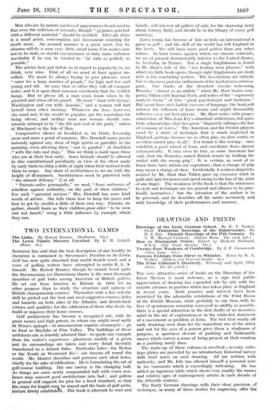TWO INTERNATIONAL GAMES
,The Links. By Robert Hunter. (Scribners. 16s.) The Lawn Tennis Masters Unveiled. By B. H. Liddell.
• (Hart. 5s.)
SOXEONE has said that the best description of any locality in literature is contained in Stevenson's Pavilion on the Links. _Golf has now quite absorbed that useful Scotch word, and a score of golfing- writers have attempted to outdo R. L. S himself. Mr. Robert Hunter, though he cannot boast quite the Stevensonian (or Darwinian) charm, is the most thorough describer of golf links among American or British golfers- 'He set out from America to Britain in 1912 for no 'other purpose than to study the structure and upkeep of 'British championship courses. Thereafter with a fine eclectic skill he picked out the best and most suggestive courses, holes and hazards on both sides of the Atlantic, and details their virtues and •qualities for the edification of those who desire to build or improve their home courses. Golf architecture has become a recognized art, with its -great names and high priests, to whom one might most aptly fit Wren's epitaph—Si monumentum requiris circumspice : go -to Deal or Hoylake or Pine Valley. The buildings of these architects are so humbly admired that—to quote one example from the writer's experience—plastieene models of a green and its surroundings are taken and every detail slavishly 'transferred to a distant links. Particular holes—the Redan or the Tenth at Westward Ho !—are famous all round the world. Mr. Hunter describes and pictures such ideal holes, chiefly for the sake of edification. He is formulating the art of golf-course building. His one enemy is the changing ball. As things are some newly compounded ball with extra resi- lience may convert good architecture into bad ; and golfers in general will support his plea for a fixed standard, so that the craze for length max be stayed and the basis of golf arehi_ .1teture firmly established. The book is pleasant to read and
handle, will interest all golfers (if only for the charming story about Johnny Ball), and should be in the library of every golf secretary... •
Lawn tennis has become of late as truly an international a game as golf ; and the skill of the world has left England-in the lurch. We still have more good golfers than any other nation. In lawn tennis, against which our climate contends, we are at present demonstrably inferior to the United States, to Australia, to France. Not a single Englishman is found in Mr. Hart's tale of the " ten leading men players," with which his little book opens, though eight Englishmen are dealt with in the concluding section. The descriptions are critical, but for the most part the enthusiasm of the laudation is extrava- gant. One thinks of the decadent Greeks welcoming Brasidas " almost as -an athlete " when Mr. Hart begins com- paring Tilden with Marshal Foch, and writes of the " supremely analytic brain " of this " great psychologist and tactician." But apart from such foolish excesses of language, the book-will interest the followers of lawn tennis and might favourably influence even our best players. Mr. Hart writes with proper admiration of Miss Joan Fry's abundant athleticism, but quite truly acknowledges that her game " flagrantly infringes the law of economy of forces." The Anierican and the 14-Yerich players excel by a study of technique that is much neglected in England, perhaps because we so often play on slow courts or so often cannot play at all ! For tennis is like rowing: once estahlish a good school of form, and excellence flows.. almost automatically. It may even be true, as some American has said, that the Dohertys ruined British tennis by holding,the racket with the wrong . grip ! It is certain, as most of us know from facts within our experience, that a change of grip may mean a change of class. Incidentally it is interesting to be assured by Mr. Hart that Tilden gave up excessive trust in guile and spin-for power and speed owing to the loss of the joint of one finger. The weakness of the book is that the references to style and technique are too general and allusive to be prac- tically instructive ; but the intention of the author is to be personal, and he. describes all his saints accurately and with knowledge of their perforMances and manner.










































 Previous page
Previous page